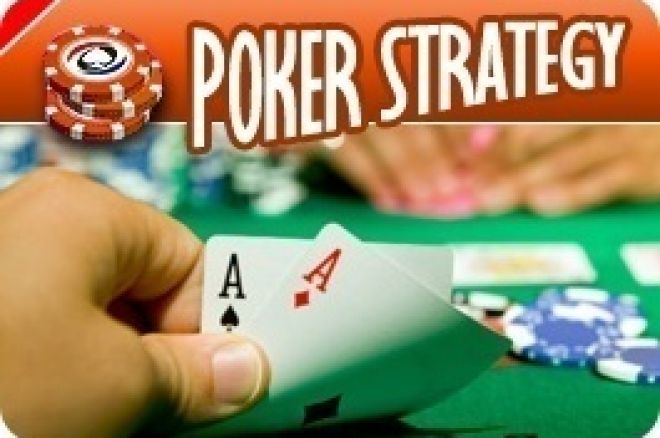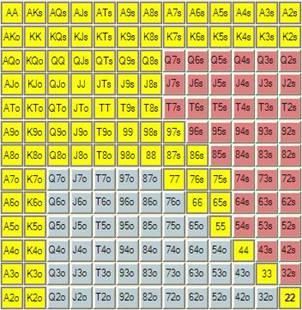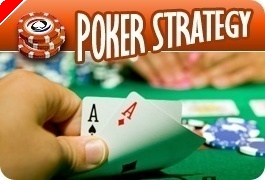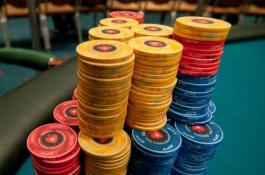What is the Gap Concept and why is it relevant?

The "Gap concept" is one of the concepts thought up by David Sklansky. The "Gap" describes the difference in hand-value of a player who raises, compared to a player who calls the raise. The Gap concept is especially useful during the late stages of a tournament.
The gap concept is an important general principle that you have to understand if you want to be a successful tournament player. Sklansky introduced the concept in his book Tournament Poker for Advanced Players. The concept basically implies that you need a better hand to call a raise of an opponent than you need when you yourself are the initial raiser. The gap is therefore the difference between the strength of a hand with which a player will call a raise and the strength of a hand with which this player will bet out.
The size of this gap depends on how your opponent plays. The concept assumes that the player who initially raises has a range of hands with which he would do so. The tighter the image of this player, the smaller the range of hands and the larger the gap between the hand-value of the raiser and the hand-value of the player considering a call. If your opponent is very loose, it could be that there is no gap at all. This concept is often used in tournament poker, especially when the blinds are very high compared to your stack.
Sklansky has developed a system for beginning No Limit tourney players:
1. If someone in front of you raised, go all-in with Aces, Kings or A-K suited. If you're not holding any of these hands, then fold.
2. If no one in front of you raised, then go all-in with every pair, A-x suited, A-K (suited or non suited) and suited connectors, except for 2-3 and 3-4
Pushing with option 2 means that you are going all-in with roughly 13% of all possible hands. Both options, however, need to be adjusted if the blinds are very high in relation to your stack size. This system clearly shows how the gap concept works. You call with a small range of hands and push with a much larger range.
In tournaments you often want to avoid confrontations with players who have shown strength, and you want to exploit the weakness of players who are trying to survive with a small stack. An important point is that a player in a late stage of a no limit tournament should not raise if a re-raise means an automatic muck for him.
Examples of the Gap Concept
All-ins happen a lot in tournaments, but Sklansky uses examples of very specific situations. "You are in tournament, sitting on the big blind. You have enough chips to call a little raise. Everyone folds to the small blind, whom makes a min-raise without looking at his cards. You look at your cards and find 3-2o. Are you going to call here? Yes! 3-2o has a 32% chance of winning against a random hand, and you get odds of 3:1 to call here."
Here's an example of applying the gap concept with a marginal hand like K9s. Imagine getting this hand in middle or late position. If a player with a considerably large stack raises in front of you, this usually indicates a relatively strong hand. A raise from an early position seems a lot stronger than a raise form late position, because this player knows there are still many players left to act behind him, and if he does get called, he is playing the rest of the hand out of position. The range of this player is likely to be AJ+ and 99+. These hands are favoured against your K9s, which is why you should fold this hand here. However, if no player in front of you has raised or limped, you can go ahead and push with this hand. There are not many players left to act behind you, and we are using the gap concept to our advantage. Weak Aces, small pairs, and maybe even AJ are likely to fold here against your all-in.
AKo is of course a good hand and even a monster in no limit and is often pushed all-in or called all-in. Going all-in preflop is often a good way to play this hand. However, it is a lot better to go all-in with this hand than calling an all-in. Against a random pair you are a slight underdog, and against any other random hand you are about a 2:1 favourite. If you yourself push all-in, many of these will be folded by your opponents, and if you do get called, you will often be up against a range of 88+ and Broadway cards.
Hand Ranges
As mentioned before, the range with which you push against a loose-aggressive player is much smaller than the range against a passive player. Against a passive player you would push with all the hands shaded yellow in the table below. Here the gap will be very big. It is, for example, not very likely that a passive player will call you with a hand like J8o. Bear in mind, however, that you still need a relatively large stack to get your opponents to fold. If a player only needs to call an extra 1BB, every player will call with any hand.
Against an aggressive player this range will be smaller. Here you will push with A9+, every pair and KJ+. Your gap is a lot smaller here, so you will need to play better hands.
The opposite counts for calling. Against a passive player, you can only call with a very small range of hands, while against a loose-aggressive player, this range will be a lot bigger. As you can see, it is very important to know about the playing styles of your opponents.
Because many players have heard/read about the gap concept, you can call a lot of steal attempts when sitting on the big blind with hands that are usually worthless. Calling with a hand like K3o or A2o is easier than calling with a low suited connector.

This kind of hand-overview is, of course, very static. It gives you a guideline against a specific kind of player, and the overview depends on the playing style of your opponent. It doesn't consider your own playing style, table dynamics, stack sizes etc.
Main Points
The Gap concept has to do with position, the player type (loose or aggressive for example) you are up against, your image, average stack, your own stack in relation to the stacks of your opponents, blind levels, number of players at the table, prize structure, bubble play and more. Here is a list of points that usually always work:
1. The closer the raiser is to the UTG position, the bigger the gap. You assume that a player raising in early position has a strong hand and raises in late position are often steal attempts.
2. The tighter the raiser, the bigger the gap.
3. The closer you are to the initial raiser, the bigger the gap. If he is UTG and you are UTG+1 you will have to use a bigger gap than when you are on the button and everyone has folded to you. If you are UTG+1 and call, there is still a big chance that more players behind you will call.
4. The bigger your opponents' stack in relation to yours, the bigger the gap. Your tourney life is on the line when you call, so you want to be sure to win.
5. The fewer players there are at the table, the smaller the gap. If you are sitting at a table with 6 players, there will be fewer players with a good hand than when you are sitting at a table with 10 players.
In his theory, Sklansky assumes that your opponents do not understand the Gap concept. However, every player with some skill will have to understand the concept if he or she will want to play tournaments profitably. The fact that your opponents do understand the gap concept can also work in your favour, when, for example, they call off your good hand with K3o. You will have to apply this concept if you want to survive in the later stages of tournaments. You can't always wait for Aces or Kings to come.
Here is a short clip in which Phil Gordon briefly explains the Gap Concept once more.







